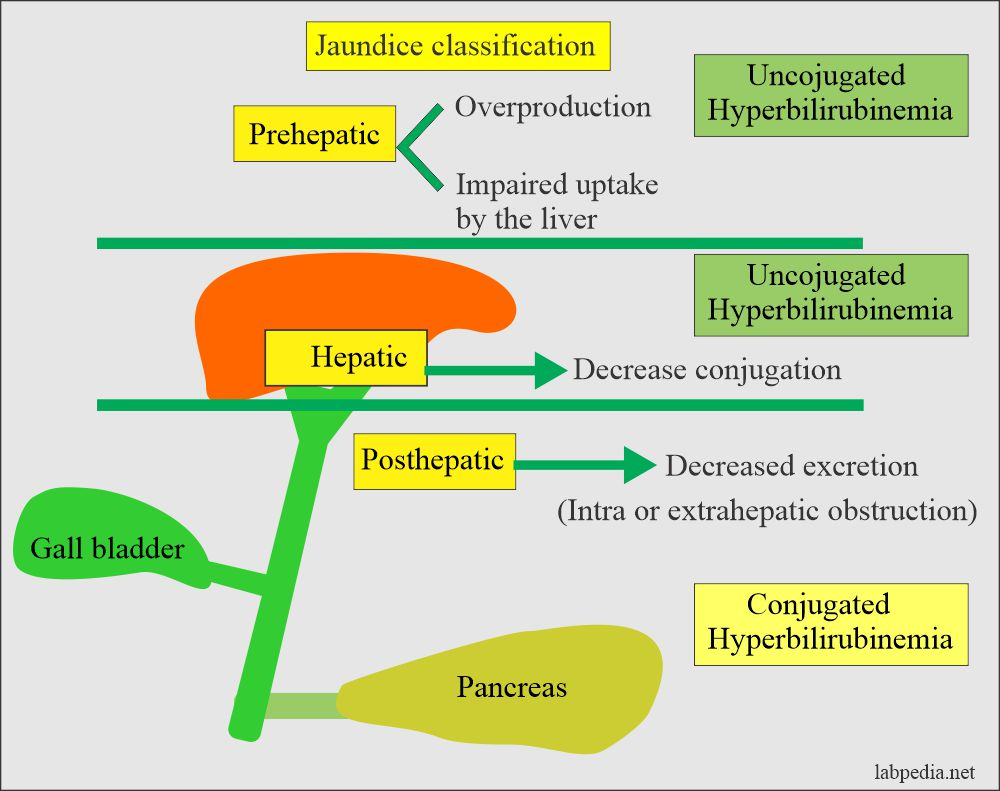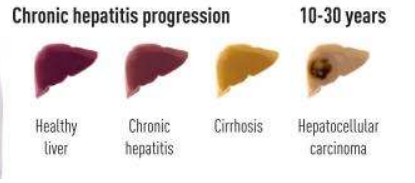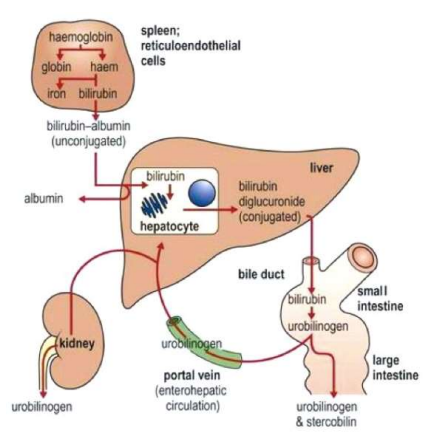
Liver
Liver Functions
detoxification
Metabolism
Immune system
protein synthesis
blood clotting factor
production of bile
Gi anti-microbial
Blood sugar balance
storage of glycogen
Storage of Micronutrients
production cholesterol
conjugation: hepatocytes combine bilirubin( produces by red blood cells) with glucuronic acid to make it water soluble
excretes in the intestine → poop + urine and gives it the color
Symptoms of Chronic Liver Failure
Encephalopathy → toxification of blood→ body
build filled belly → ascites
increased pressure in the portal vein cause fluid to leak from blood vessels into the peritoneal cavity and cause edema → fluid-filled belly
treatment:
build a bypass
paracentesis (removal of the fluid from the abdomen with a needle)
liver transplant
increased bleeding
low platelets and clotting factor
eyes turn yellow → jaundice → icterus
hemoglobin breakdown → bilirubin
first in the eyes because its the whitest and very fatty
classification of different types of jaundice
portal hypertension
increased blood flow due to resistance (fibrosis)
variceal bleeding
due to portal hypertension blood vessels in the esophagus and stomach become enlarged and weakened ( looking like worms) → they can explode
shunting
red hand palms
spider (rashes)
edema
bilateral enlargement of breast tissue
bleeding
low amounts of platelets because they are stored in liver
pressure on the venus system
liver makes clotting factor → less clotting factors in bloody
too many blood cells
stones in are in duct * turn yellow * the stool is less yellow
Gynecomastia: bilateral enlargement if the male breast tissue
in liver failure
the liver fails to metabolize estrogen, this hormonal imbalance causes the breast development
Jaundice
Three types:

Why is jaundice more common in babies?
they have higher red blood cells than adults
the life span of erythrocytes is shorter( different hemoglobin)
the liver is not as good at conjugation yet
bowel movements are slower in babies than in adults
Treatment:
Phototherapy: UV lights make bilirubin water soluble
Hepatitis
most common cause of hepatitis and progression?
Viral infection → becoming chronic
hepatitis a+b+c+d +e

Hepatitis Virus
symptoms for liver infection?
→ same as liver failure symptoms
Characteristics:
Hepatitis Virus | Type of Virus | Genetic Material | Transmission | Treatment |
|---|---|---|---|---|
Hepatitis A | HAV | Single-stranded RNA | playground Fecal-oral route, contaminated food or water | No specific treatment, usually resolves on its own“least lethal” |
Hepatitis B | HBV | Double-stranded DNA | Blood, semen, vaginal fluids, and other bodily fluids | Antiviral medications, immune modulators, and/or liver transplant |
Hepatitis C | HCV | Single-stranded RNA | Blood-to-blood contact | Antiviral medications, immune modulators, and/or liver transplant |
Hepatitis D | HDV | Single-stranded RNA | Blood-to-blood contact, can only infect individuals who are already infected with HBV | Antiviral medications and/or liver transplant |
Hepatitis E | HEV | Single-stranded RNA | Playground Fecal-oral route, contaminated food or water | No specific treatment, usually resolves on its own |
Target Areas for Antiviral Medication
Inhibit the virus from invading the host by not letting the virus produce proteins that help them evade the immune system
prevent viral assembly of proteins by inhibiting viral enzymes involved in the process of replication
genome replication
polyprotein processing
attachment to the cells
inhibition in the assembly process of virus
inhibition of molecular structure
Liver
Liver Functions
detoxification
Metabolism
Immune system
protein synthesis
blood clotting factor
production of bile
Gi anti-microbial
Blood sugar balance
storage of glycogen
Storage of Micronutrients
production cholesterol
conjugation: hepatocytes combine bilirubin( produces by red blood cells) with glucuronic acid to make it water soluble
excretes in the intestine → poop + urine and gives it the color
Symptoms of Chronic Liver Failure
Encephalopathy → toxification of blood→ body
build filled belly → ascites
increased pressure in the portal vein cause fluid to leak from blood vessels into the peritoneal cavity and cause edema → fluid-filled belly
treatment:
build a bypass
paracentesis (removal of the fluid from the abdomen with a needle)
liver transplant
increased bleeding
low platelets and clotting factor
eyes turn yellow → jaundice → icterus
hemoglobin breakdown → bilirubin
first in the eyes because its the whitest and very fatty
classification of different types of jaundice
portal hypertension
increased blood flow due to resistance (fibrosis)
variceal bleeding
due to portal hypertension blood vessels in the esophagus and stomach become enlarged and weakened ( looking like worms) → they can explode
shunting
red hand palms
spider (rashes)
edema
bilateral enlargement of breast tissue
bleeding
low amounts of platelets because they are stored in liver
pressure on the venus system
liver makes clotting factor → less clotting factors in bloody
too many blood cells
stones in are in duct * turn yellow * the stool is less yellow
Gynecomastia: bilateral enlargement if the male breast tissue
in liver failure
the liver fails to metabolize estrogen, this hormonal imbalance causes the breast development
Jaundice
Three types:

Why is jaundice more common in babies?
they have higher red blood cells than adults
the life span of erythrocytes is shorter( different hemoglobin)
the liver is not as good at conjugation yet
bowel movements are slower in babies than in adults
Treatment:
Phototherapy: UV lights make bilirubin water soluble
Hepatitis
most common cause of hepatitis and progression?
Viral infection → becoming chronic
hepatitis a+b+c+d +e

Hepatitis Virus
symptoms for liver infection?
→ same as liver failure symptoms
Characteristics:
Hepatitis Virus | Type of Virus | Genetic Material | Transmission | Treatment |
|---|---|---|---|---|
Hepatitis A | HAV | Single-stranded RNA | playground Fecal-oral route, contaminated food or water | No specific treatment, usually resolves on its own“least lethal” |
Hepatitis B | HBV | Double-stranded DNA | Blood, semen, vaginal fluids, and other bodily fluids | Antiviral medications, immune modulators, and/or liver transplant |
Hepatitis C | HCV | Single-stranded RNA | Blood-to-blood contact | Antiviral medications, immune modulators, and/or liver transplant |
Hepatitis D | HDV | Single-stranded RNA | Blood-to-blood contact, can only infect individuals who are already infected with HBV | Antiviral medications and/or liver transplant |
Hepatitis E | HEV | Single-stranded RNA | Playground Fecal-oral route, contaminated food or water | No specific treatment, usually resolves on its own |
Target Areas for Antiviral Medication
Inhibit the virus from invading the host by not letting the virus produce proteins that help them evade the immune system
prevent viral assembly of proteins by inhibiting viral enzymes involved in the process of replication
genome replication
polyprotein processing
attachment to the cells
inhibition in the assembly process of virus
inhibition of molecular structure
 Knowt
Knowt